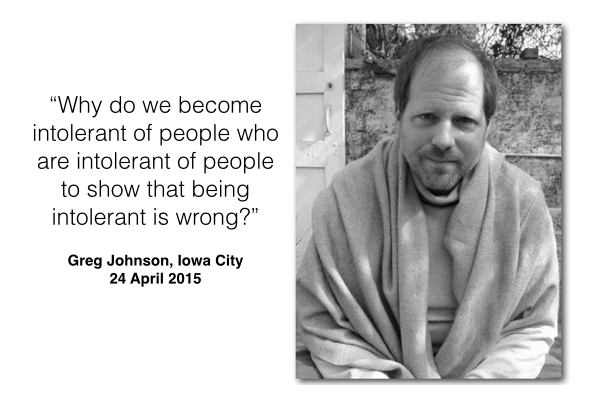Many years ago, I was walking to shul on Shabbos with a Jewish friend and we were discussing anti-Semitism. At the time, there’d been a rise in world-wide attacks on synagogues and an increase in anti-Semitic propaganda. We talked about the futility of direct engagement with hateful intolerant racists and bigots.
I looked at my friend and said, “I think the best response to anti-Semitism is more Judaism.” Having more people living an authentic and compassionate Judaism engaged in acts of kindness and Tikkun Olam is the best antidote for anti-Semitism.
I’m not Jewish, but over the years I’ve periodically participated in the faith and found it to be thought provoking, inspiring, and a source of wisdom for how to live a more abundant life. During times of persecution, being intentional about supporting and connecting with Jewish community seems like a good thing to do. Promoting acceptance and understanding is always a good choice.
A few years ago, in one community suffering from a wave of anti-Jewish attacks, hundreds of households put menorahs in their windows as a gesture of solidarity. This also made it difficult for any one household to be singled out.
Unfortunately, ignorance, bigotry, hatred, and intolerance seem to be part of the same parasitic disease that has continued to harm humanity over the centuries. We imagine that society will advance beyond these things. That’s the hope at least. Yet, dormant intolerance rises again, like some kind of recurring skin rash.
Today, hate crimes against blacks are on the rise. Innocent unarmed black people are getting shot in the streets in broad daylight. “Someone call the police!” might be a reasonable response, except it’s the police who are doing the shooting.
Muslims are probably tied for first place with regard to persecution and being misunderstood, at least in America.
The LGBT community continues to struggle for their rights in the face of intolerance and hatred.
What’s the appropriate response?
Negative stereotypes and misrepresentations in the news serve as fertilizer for hatred and misunderstanding. So, an appropriate and effective response is to flood the media and social media with positive images and positive portrayals of blacks, Jews, Muslims, gays, and people from any other persecuted or misunderstood minority group. This can help counteract the negativity of harmful propaganda.
It’s important for young people growing up to have healthy and positive views about themselves and others. If you’re part of a minority group — it’s important to grow up seeing that you are part of a group that is prosperous, successful, accepted, and respected.
Positive portrayals in advertising, movies, television, and popular media can go a long way to instill confidence in young people, as explained in this quote from Whoopi Goldberg:
“Well, when I was nine years old Star Trek came on. I looked at it and I went screaming through the house, ‘Come here, mum, everybody, come quick, come quick, there’s a black lady on television and she ain’t no maid!’ I knew right then and there I could be anything I wanted to be.” ~ Whoopi Goldberg
If you’re part of the majority, it’s important to have repeated positive images and portrayals of minorities that you might not otherwise have contact with.
A recent high profile incident regarding LGBT intolerance is the story about Memories Pizza of Walkerton, Indiana. This is the restaurant that refused to cater a same-sex wedding. Overnight, the small town pizza shop became the target of a verbal firestorm of vitriolic language expressing anger and hatred over their intolerance of same-sex marriage. Their Facebook page continues to be inundated with hateful responses to their position on same-sex marriage.
In the midst of the backlash of anger, a lesbian couple from California sent a $20 donation to the pizza shop. According to a report in the Huffington Post on 18 April 2015:
Courtney Hoffman, who is a California resident, said she hoped her $20 donation would be seen as an apology for the “hate and intolerance” that has been directed at Memories Pizza, and added that she “fully” supports the pizzeria owners’ right to “stand up” for their beliefs, TheBlaze first reported.
“My girlfriend and I are small business owners, and we think there is a difference between operating in a public market space and then attaching the name of your business to a private event,” she said in the interview, which can be found here. “If we were asked to set up at an anti-gay marriage rally, I mean, we would have to decline.”
Hoffman, who operates a small kettle corn stand with her girlfriend, also noted, “If we can remember that differences don’t equal maliciousness, and try to find what we have in common … maybe we can move beyond threats of violence and have open discussions of the things that we don’t agree on.”
Courtney Hoffman’s action above is an excellent example of effective activism. It’s also a genuine and sincere act of kindness that hopefully can open doors, build bridges, promote understanding, and bring about positive social change.
It’s probably human nature to respond ‘in kind’ to whatever comes our way. If someone yells at us, we yell back. If they call us names, we call them names. The problem, of course, is that this causes us to get sucked into engaging in the very same behavior that we’re protesting.
It turns out that the owner of Memories Pizza is not vehemently anti-gay, but simply doesn’t support gay marriage. While that may sound moderately anti-gay to some people, there is a difference. Had the pizza owner met some nice married gay couples, he might have changed his stance on gay marriage. Unfortunately, voices of reason and and understanding were drowned out by all the hateful responses.
In the midst of these conflicts, I wonder to myself, “Why do we become intolerant of people who are intolerant of people to show that being intolerant is wrong?”
Courtney’s example reminds us to take the higher road. We can stop protesting what we’re against and instead boldly and bravely live out what we are for.

__________
Additional Reflections
It’s relevant to point out that there’s a growing subculture of conservative evangelical Christians who probably feel that they are a misunderstood minority — being portrayed by the media as an extremist and hateful people who are bitter and “clinging to guns or religion.”
In April 2008, President Barack Obama stated about evangelical conservatives:
“…it’s not surprising then that they get bitter, they cling to guns or religion or antipathy to people who aren’t like them or anti-immigrant sentiment or anti-trade sentiment as a way to explain their frustrations,” (source)
Obama isn’t alone in this viewpoint. His statement reflects how conservative evangelicals are often portrayed by mainstream media.
In the same way the media focuses on Muslim religious extremists and militants, it also focuses on Christian religious extremists and militants. Religious conservatives (of any religion) are generally portrayed as angry, isolated, uneducated, and bitter — a group that nobody would want to belong to.
Interestingly, what are perceived to be the most ‘religious’ evangelicals are actually very outspoken against religion. There’s a belief among many Christians that religious structures of worship, thought, interaction, and living hinder the influence of the Holy Spirit. The subtleties and nuances of the faith and ‘a relationship with Jesus’ are found in living out a less religiously-structured worship and life of faith. Religion with its huge administrative top-down institutions, detailed doxology, and written prayer books becomes something larger and noisier than the still small voice — and thus a distraction.
In an interview on the Jon Stewart show, Mike Huckabee proclaimed “I’m a conservative, but I’m not angry about it.”
Huckabee was known for that statement because he’d use it in may speeches and television interviews. It was an important clarification to make since people like him are otherwise being portrayed as angry at the world.
There are many evangelical conservatives who aren’t uneducated, angry, or bitter. They just want to have the freedom to live their own life in a conservative religious way.
So, ironically, a group that’s often portrayed as the oppressor (conservative evangelicals), actually isn’t that large in number and is itself in danger of being an oppressed or misunderstood minority group. In some respects, conservative evangelicals are an endangered sub-culture that no longer have a cultural ecosystem to support and affirm its existence.
It’s not the case anymore that “the man” is keeping a certain group down, but we have disagreeing factions of minority groups and special interests who are all to some degree oppressed by another — fighting over jobs, political influence, and power.


